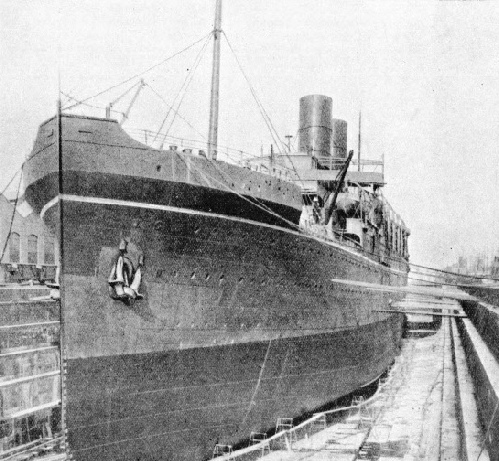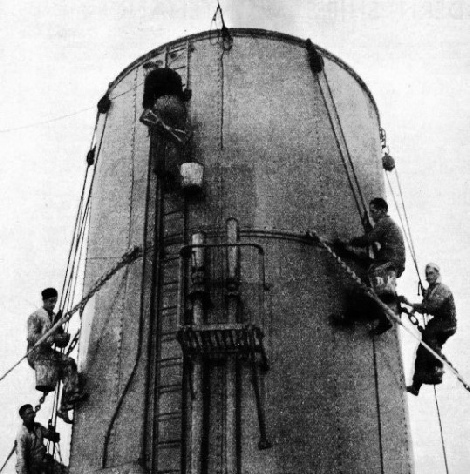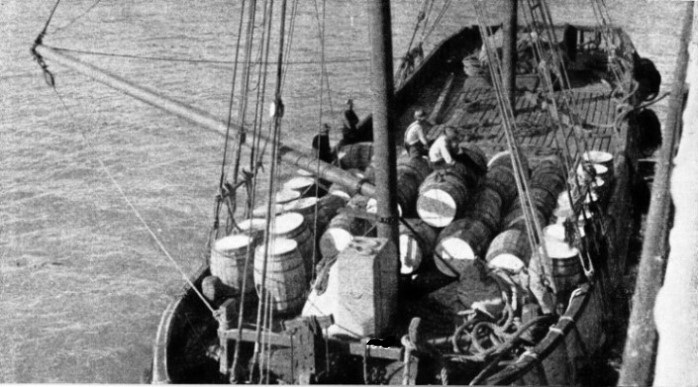

© Shipping Wonders of the World 2012-

The Modern Ship’s Maintenance
The debit side of the shipowner’s accounts includes many heavy expenses of which the passenger knows little. The interior and the exterior of the ship must be frequently examined and all deterioration made good. Maintenance of the machinery alone entails a huge expenditure

KING GEORGE V DOCK, London, provides accommodation for vessels up to 30,000 tons. Dry dock rents vary with the size of the ship to be docked, but may amount to £150 or £200 a day. The Kaisar-
THE modern ship carries such an immense amount of cargo and so many passengers that people are apt to form an unduly optimistic view of the potential profits of shipowning. It is easy to forget that the ship is seldom full, and the expenses which have to be met are surprising to people not connected with shipping.
Generally speaking, passenger fares are considerably higher than they were before the war of 1914-
It would be impossible to keep the ships at sea if the owners had not been able to reduce the running expenses by mechanical improvement. As a rule this has reduced the number of men employed, but has entailed a capital expenditure which has to be considered all through the life of the ship in overhead costs.
Overhead costs, principally the charges which are made on capital expended and depreciation, are big items in the owner’s calculations and are often lost sight of even by the merchant who has to deal with shipping and who considers himself hardly treated by the cost. The Inland Revenue generally allows 4 per cent to be written off as depreciation, but in most ships this is insufficient. It presupposes a life of twenty-
Some are admittedly good dividend earners at a much greater age, but with passenger liners, especially, eighteen years is a good life on which the owners can congratulate themselves. When times are bad and freights are low, the owner will often find it impossible to allow for this depreciation, which means a bigger burden later on, or a writing down of capital, whereby somebody is bound to lose money.
The company which caters for the travelling public has to make a big allowance for changes in fashion. Competition is keen and the ship which is conspicuously old-
It is often necessary to increase the speed of a ship, either to keep her in favour with the public or else to satisfy a new and more severe mail contract. Here again a bill has to be faced which often makes it doubtful whether a new ship would not be an economy.
Even when the owner has everything in his favour, and nothing out of the way has to be done, the normal expenses of running a modern ship are colossal. One of the first things to be considered is a big annual outlay on the insurance of the ship’s hull, for which the premium depends largely on the record of the owners and their officers.
This annual drain on the accounts of the companies is so great that many owners prefer to insure their ships themselves, either wholly or partly.
The hull of a ship has to be completely painted at least three times a year if it is to be kept in good order. When the ship’s company has nothing much to do in a foreign port the seamen are often put on to painting, but when the ship is at home they are paid off and painters invade the ship and cover her side with a new coat at extraordinary speed. Periodically all the paint has to be taken off, for it may be hiding what is going on in the plate under it, and corrugation caused by corrosion may reduce the speed of the ship.
A constant and careful watch has to be kept on corrosion, which may be attaining dangerous proportions in a ship whose well-
No matter how carefully they are covered by anti-
Expensive Surveys
The bottom is covered by grass, barnacles and other marine growths, and the speed of the ship is greatly reduced, the fuel consumption increased, and structural deterioration may become serious. Periodically, therefore, the ship has to be put into dry dock for cleaning. This is an expensive matter.
Sometimes the dry docks are owned by the port authorities, sometimes by independent concerns and sometimes by the firms which undertake the repairs. The basis of cost, therefore, varies, and much depends also on the dry dock available. Rents vary, but from £150 to £200 per day is an average rent for dry dock accommodation for a first-
The periodical surveys upon which the authorities and the classification societies insist to make quite sure of the safety of the ship also cost a lot in dry-
A British passenger ship has to pass through her Board of Trade survey every year. This entails dry-
The interior of the ship is just as carefully examined for weakness that could possibly lead to disaster. The tanks, holds, decks and the insulation of refrigerated spaces, whether holds or storerooms, are investigated. The insulation in particular is liable to show faults which are costly to eradicate. Rats in the ship can do much harm. Dry rot and many other troubles may also set in.
 Every part of the life-
Every part of the life-
PAINTING THE FUNNEL of a ship is a simple routine item of maintenance, but may cost as much as £250 a year. This photograph shows men at work in the Ruahine. This twin-
The least sign of deterioration is detected, and whatever is faulty is ruthlessly rejected and replaced before the ship is given her certificate. In addition to these surveys there is the special load-
The propelling and auxiliary machinery are also constantly under survey, and their maintenance most expensive. There is always wear and tear to be detected and corrected; constant renewals demand skilled labour at skilled rates; minor fittings are always being installed with the object of improving efficiency and economy. Every time the engines are stopped for a few hours the opportunity is taken to examine them, to overhaul them as much as possible and to pack all glands and tighten up wherever necessary. Keeping the engines really fit is a never-
The furniture of a passenger ship is also subject to a good deal of wear, and it would never do for it to appear shabby. Repairs are always needed; on the voyage much work is done by tradesmen among the crew, but a shore staff has to be maintained at the terminal ports. As a general rule, every item of furniture in the ship is freshly polished at the beginning of each voyage.
The ordinary running costs of oil fuel, wages, victualling and the like are easily understood by the veriest tyro, but there are generally many items which are omitted from his calculations. Various inventions which have recently been put on the market reduce the fuel consumed in driving the ship and in supplying the various auxiliary services, but the savings which they effect have to be carefully balanced with the cost of their installation and the interest on the money. The condition of the engines and hull must be examined to see whether the ship will last long enough for the improvements to cover that cost.
As the prices of bunkers vary at every port, the owner has to arrange his schedule so that his ship can fill up at the cheapest port on her route. It is also necessary to decide which is the cheaper method of buying — by contract or through a subsidiary company.
Lubricating oil is equally necessary, and it can run up a large bill in the course of a voyage. The demand varies with the type and condition of the engines, but the steam turbine is more economical in oil than any sort of reciprocator, and the diesel, with its low consumption of fuel, demands more lubricating oil than other types. Shortsighted economy in the quality of the oil bought is likely to involve additional expenditure.
People ashore are so used to having unlimited supplies of fresh water available that they forget that it has to be carefully conserved on board ship and that it is a big item in the running expenses. That is why spring taps are nearly always fitted to cabin washbasins. Even the first-
Water at Eleven Shillings a Ton
The ship takes in as much water as possible at the ports where it is cheapest, but the demand is so huge that it is impossible to take in at any one point all the water that is wanted for a long voyage. Fresh water on board a ship in the Port of London costs about 8d. per ton, but at Aden, where it all has to be condensed from the sea, it costs 11s. 6d. Thousands of tons are used by a big ship, a hundred tons a day being moderate for a passenger vessel.
Every time the whistle blows, or the safety valve lifts, precious water is lost into the atmosphere. For washing, laundry, cleaning, cooking, drinking and a score of other things it is also necessary. In an emergency a certain amount of fresh water can be distilled by the ship herself, but the process is apt to be decidedly expensive.
The officers and crew of any ship, even a modest tramp, go home with a “payday” that would surprise most landsmen at the end of every voyage. Nowadays a minimum scale is laid down for every rank and rating after infinite argument on the National Maritime Board. The companies often voluntarily exceed it by a large margin to get the good men that they want to run their ships.
The owner calculates his wages, as far as possible, on the earning ability of the ship. With the ordinary seasonal passenger traffic the ships generally have to make their passage in one direction almost empty, yet the owner must pay for sufficient stewards, almost idle on the one passage, to attend to all the wants of the passengers on the return. In many instances overtime has to be paid at generous rates or a holiday granted on pay after the men would normally be paid off.

LOADING CARGO into or discharging from a hatch by the ship’s derricks or shore cranes is an operation which takes place at nearly every port of call. Each call involves heavy expenditure, such as the dues payable for use of cranes, tolls on goods handled in and out, and charges for mooring, pilotage and tug service. The ship illustrated is the Ruahine, of 10,870 tons gross. She belongs to the New Zealand Shipping Compay.
Fortunately the waste in feeding a crew is not nearly as bad as it is in feeding the passengers. It is necessary to prepare meals on the assumption that every passenger is coming down with a good appetite, but the passenger liner provides a bill of fare as varied as that of any restaurant ashore, and so much choice is offered that there is bound to be waste. Even the healthy appetites of the crew cannot make up for it. The choice of a liner to-
Happy is the owner who can arrange his route with the minimum of calls, but business is so difficult to find nowadays that the tendency is to increase the number in the constant attempt to fill the ship. Unfortunately, every call runs up a heavy bill. Whenever the ship gets into soundings approaching a port, or rounding some obstruction, she benefits by the lights and navigation marks, and these have to be paid for by means of light dues or some other equivalent tax, which can be a heavy burden on the accounts of the ship.
In and out of port the cost of pilotage is also a heavy item, especially in the compulsory areas, where the rates are laid down and there is no possibility of a bargain. In most places, however, the pilots are highly skilled, work hard for their money and have much at stake in the event of any mishap, so that it is only fair that they should be paid specialist rates.
Most of the best companies value the services of the pilots so highly that they are not content merely to observe the compulsory regulations, but also have a system of “choice” pilots whereby their ships can always have the services of a man they know. A ship entering the Port of London, for instance, will often have her “choice” pilot sent down to meet her at Plymouth. He takes charge off the Isle of Wight and has to be paid accordingly, though it would be much cheaper for the ship to pick up her pilot out of the cutter cruising off Dungeness.
The dues charged by the authorities at each port of call are another expense. Among the most usual are the tonnage dues for being in the port at all, and additional charges for mooring, use of cranes, tolls on goods handled in and out, tolls on passengers’ luggage, landing and embarkation fees.
Allowance for Contingencies
The modern liner invariably requires the services of tugs to get her safely alongside and to get her off again. Two may be sufficient, or the job may demand three, four or more, but they all have to be paid for and the ship has to stand her share of the time that the tugs are idle waiting for employment.
The owner also has to pay a considerable bill for the services of the Customs. He has to pay them for entering and clearing the ship, for attending to the bonded stores on board and for general attendance on the ship.
Dockers’ and stevedores’ labour is another big item which demands careful calculation on the part of the owners. As time in port is time wasted, where overhead costs are concerned, it has to be judged to a nicety. The necessary men are engaged so that they can do the work as efficiently as possible. The dockers, whose casual labour is anything but easy, can only be engaged by the half-
The ship’s people have to calculate when she is going to arrive — not a difficult matter nowadays with the services of wireless, but always liable to be thrown out by fog or some such reason — and to have the necessary labour waiting for her.
If a company is making extensive use of a port, especially as a terminal, a good deal of expense is incurred in renting storage space for gear and spares.
Full allowance must also be made for various liabilities. Against some of them The owner can... insure, although the premiums cost him a good deal. Many claims by cargo owners and passengers are not so covered and can run into large sums. Some of these are fully justified, but others are paid to avoid troublesome litigation and unwelcome publicity. Claims on damage incurred by cargo while it is being carried amount to a huge total in the course of a year and the shipowner also has to contend with any amount of pilferage. Altogether the debit side of the shipowner’s accounts mounts up in a manner which is almost incredible to anybody who has had no experience of it.

HANDLING THE CARGO during loading and unloading operations calls for the greatest care. Many claims by cargo owners are not covered by insurance, and may involve the shipowners in the payment of large sums. At the same time cargo must be handled expeditiously, without interfering with the scheduled time of departure from a port; otherwise it would be necessary to pay the dockers for overtime.
You can read more on “Instruments of Navigation”, “Navigational Charts” and
“Romance of the Chronometer” this website.